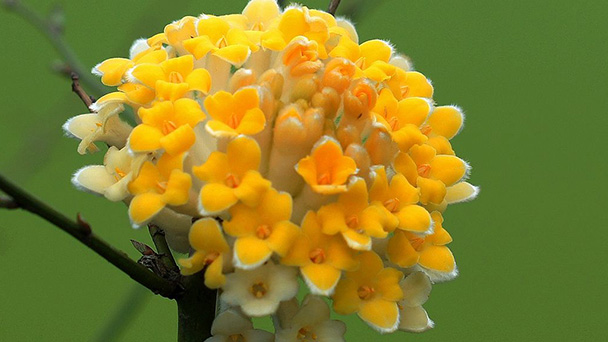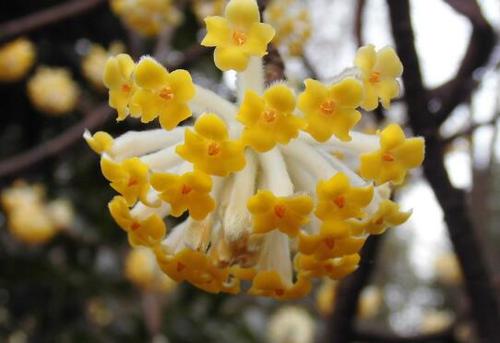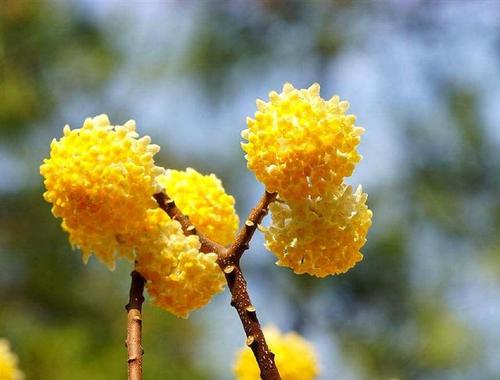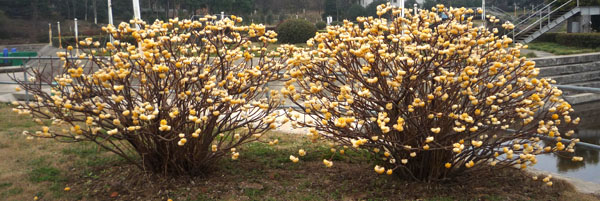Edgeworthia chrysantha Lindl profile
Written by Maggie
Nov 17 2020

Edgeworthia chrysantha Lindl is a deciduous shrub with fragrant flower buds of the chrysantha family. Place of Origin: Produced in the south of the Yangtze River and Henan, Shaanxi and other places. Picking part: flower bud. In the late winter and early spring, the inflorescences are picked and dried. Functions and indications: calming nerves, improving eyesight, removing obstacles.
Edgeworthia chrysantha Lindl picture

Morphological characteristics of Edgeworthia chrysantha Lindl
Edgeworthia chrysantha Lindl is a deciduous shrub, up to 2 meters high, the whole plant is silky pilose or long hirsute, denser when young. The branches are brownish-red, often 3-forked branches with lenticels. Single leaves alternate, usually clustered at the ends of branches, papery, elliptical oblong or elliptical-lanceolate, 8-16 cm long, 2-3.5 cm wide or slightly wider, base wedge-shaped, descending. Apex is sharp or sharp obtuse, entirely, sparsely hairy on the top, glabrous on the back, and pinkish green on the bottom, with bristles. The veins are dense and the veins are raised. The flowers are numerous, yellow, fragrant, with terminal headlike inflorescences, drooping. The total pedicel is thick, densely silky, the involucre is pilose. The pedicel is absent or very short: the calyx is cylindrical, and the outside is silky and soft Hairs, lobes 4, petaloid, ovate, spreading; no petals; stamens 8, two rounds, inserted on the upper part of the calyx tube, extremely short filaments, oblong anthers; ovary elliptic, sessile, only upper part softened Hair, 1 compartment, 1 ovule, slender style, linear cylindrical stigma, pilose. The drupe is ovoid, usually at the base of the perianth, leathery, hard and brittle. Flowering period is from March to April. The fruit period is about August.

Edgeworthia chrysantha Lindl distribution range
(1) Ecological environment: edgeworthia chrysantha lindl is born in hillsides, valleys, forests and bushes.
(2) Resource distribution: edgeworthia chrysantha Lindl is distributed in Hebei, Shaanxi, Jiangsu, Anhui, Zhejiang, Jiangxi, Henan, Guangdong, Guangxi, Sichuan, Yunnan and other places.

Latest Updated
- Benefits of Bugleweed - 7 Science-backed Health Benefits
- Bugleweed Dangers & Side Effects - Is It Poisonous?
- How to Plant Evergreen Trees - What You Should Know
- When to Plant Evergreens - Grow Guide for Evergreen Trees
- 12 Wonderful Evergreen Shrubs for Your Garden
- 12 Popular Evergreen Plants with Pictures for Beginners
- When And How To Prune A Lilac Bush Like a Pro
- How to Grow & Care for Lilac Vine (Hardenbergia Violacea)
- Japanese Lilac Tree (Syringa Reticulata) Care & Propagation Guide
- Shumard Oak Pros and Cons - What to Know
Popular Articles
- Winter maintenance of Antirrhinum Majus
- How to Grow Terminalia Mantaly Tree
- How to Grow and Care for Crossostephium Chinense
- How to grow Antirrhinum Majus in spring
- Peristeria Elata (Dove Orchid) Profile: Info & Care Guide
- Underwatered Snake Plant (Sansevieria Trifasciata) - Signs And How To Fix
- How to Care for Brazilian Jasmine Plant (Mandevilla Sanderi)
- How to Grow & Care for Graptopetalum Purple Delight in Summer
- Rosa Chinensis (China Rose): Plant Growing & Care Tips
- How to Care for Baby Sun Rose (Aptenia Cordifolia)